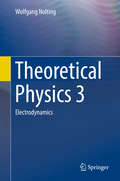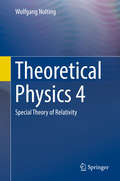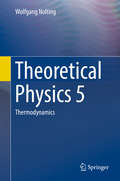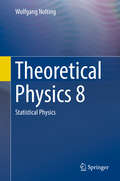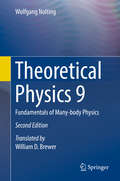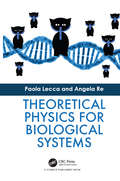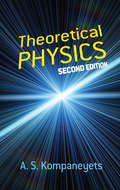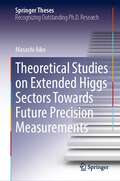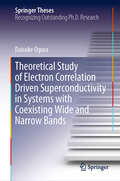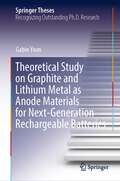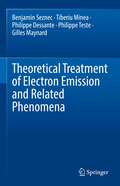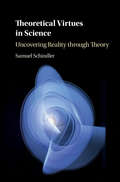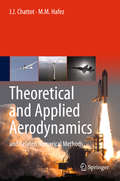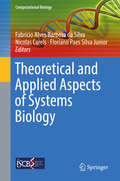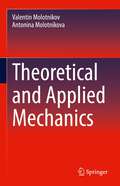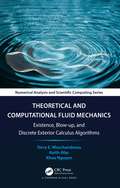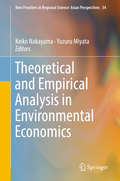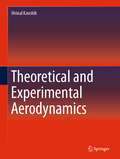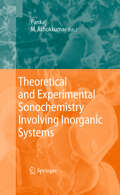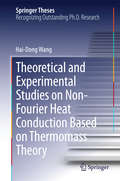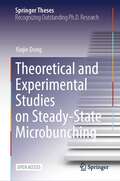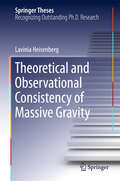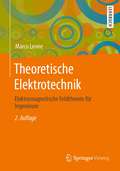- Table View
- List View
Theoretical Physics 2
by Wolfgang NoltingThis textbook offers a clear and comprehensive introduction to analytical mechanics, one of the core components of undergraduate physics courses. The book starts with a thorough introduction into Lagrangian mechanics, detailing the d'Alembert principle, Hamilton's principle and conservation laws. It continues with an in-depth explanation of Hamiltonian mechanics, illustrated by canonical and Legendre transformation, the generalization to quantum mechanics through Poisson brackets and all relevant variational principles. Finally, the Hamilton-Jacobi theory and the transition to wave mechanics are presented in detail. Ideally suited to undergraduate students with some grounding in classical mechanics, the book is enhanced throughout with learning features such as boxed inserts and chapter summaries, with key mathematical derivations highlighted to aid understanding. The text is supported by numerous worked examples and end of chapter problem sets. About the Theoretical Physics series Translated from the renowned and highly successful German editions, the eight volumes of this series cover the complete core curriculum of theoretical physics at undergraduate level. Each volume is self-contained and provides all the material necessary for the individual course topic. Numerous problems with detailed solutions support a deeper understanding. Wolfgang Nolting is famous for his refined didactical style and has been referred to as the "German Feynman" in reviews.
Theoretical Physics 4
by Wolfgang NoltingDer Grundkurs Theoretische Physik deckt in 7 B#65533;nden alle f#65533;r das Diplom und f#65533;r Bachelor/Master-Studieng#65533;nge ma#65533;geblichen Gebiete ab. Jeder Band vermittelt das im jeweiligen Semester notwendige theoretisch-physikalische R#65533;stzeug. #65533;bungsaufgaben mit ausf#65533;hrlichen L#65533;sungen dienen der Vertiefung des Stoffs. Der 4. Band behandelt die Gebiete Thermodynamik und Relativit#65533;tstheorie. F#65533;r die Neuauflage wurde er grundlegend #65533;berarbeitet und um 24 Aufgaben erg#65533;nzt. Durch die zweifarbige Gestaltung ist der Stoff jetzt noch #65533;bersichtlicher gegliedert.
Theoretical Physics 5
by Wolfgang NoltingDer Grundkurs Theoretische Physik deckt in 7 B#65533;nden alle f#65533;r das Diplom und f#65533;r Bachelor/Master-Studieng#65533;nge ma#65533;geblichen Gebiete ab. Jeder Band vermittelt das im jeweiligen Semester notwendige theoretisch-physikalische R#65533;stzeug. #65533;bungsaufgaben mit ausf#65533;hrlichen L#65533;sungen dienen der Vertiefung des Stoffs. Der 4. Band behandelt die Gebiete Thermodynamik und Relativit#65533;tstheorie. F#65533;r die Neuauflage wurde er grundlegend #65533;berarbeitet und um 24 Aufgaben erg#65533;nzt. Durch die zweifarbige Gestaltung ist der Stoff jetzt noch #65533;bersichtlicher gegliedert.
Theoretical Physics 8: Statistical Physics
by Wolfgang NoltingDer Grundkurs Theoretische Physik deckt in 7 Bänden alle für das Diplom und für Bachelor/Master-Studiengänge maßgeblichen Gebiete ab. Jeder Band vermittelt das im jeweiligen Semester notwendige theoretisch-physikalische Rüstzeug. Übungsaufgaben mit ausführlichen Lösungen dienen der Vertiefung des Stoffs. Der 6. Band zur Statistischen Physik wurde für die Neuauflage grundlegend überarbeitet und um aktuelle Entwicklungen ergänzt. Durch die zweifarbige Gestaltung ist der Stoff jetzt noch übersichtlicher gegliedert.
Theoretical Physics 9: Fundamentals of Many-body Physics
by Wolfgang NoltingThis textbook addresses the special physics of many-particle systems, especially those dominated by correlation effects. It develops modern methods to treat such systems and demonstrates their application through numerous appropriate exercises, mainly from the field of solid state physics. The book is written in a tutorial style appropriate for those who want to learn many-body theory and eventually to use this to do research work in this field. The exercises, together with full solutions for evaluating one's performance, help to deepen understanding of the main aspects of many-particle systems.This revised second edition presents new sections on the finite-temperature Matsubara formalism, in particular with respect to Dyson equation, the Hartree-Fock approximation, second order perturbation theory, spin density waves, Hubbard model, Jellium model, quasi particles, Fermi liquids and multi particle Matsubara functions.Completing the outstanding Theoretical Physics series, this book will be a valuable resource for advanced students and researchers alike.
Theoretical Physics for Biological Systems
by Paola Lecca Angela ReQuantum physics provides the concepts and their mathematical formalization that lend themselves to describe important properties of biological networks topology, such as vulnerability to external stress and their dynamic response to changing physiological conditions. A theory of networks enhanced with mathematical concepts and tools of quantum physics opens a new area of biological physics, the one of systems biological physics.
Theoretical Physics: Second Edition (Dover Books on Physics)
by A. S. KompaneyetsThis authoritative volume by a renowned Russian scientist offers advanced students a thorough background in theoretical physics. The treatment's review of basic methods takes an approach that's as rigorous and systematic as it is practical.Chiefly devoted to mechanics, electrodynamics, quantum mechanics, and statistical mechanics, this book stresses atomic, nuclear, and microscopic matters. Subjects include the quantum theories of radiation, dispersal, and scattering and the application of statistical mechanics to electromagnetic fields and crystalline bodies. Particularly strong in its coverage of statistical physics, the text examines Boltzmann statistics, Bose and Fermi distributions, Gibbs statistics, thermodynamic quantities, thermodynamic properties of ideal gases in Boltzmann statistics, fluctuations, phase equilibrium, weak solutions, chemical equilibria, and surface phenomena. Many of the 137 exercises feature complete solutions. Translated by George Yankovsky under the author's supervision.
Theoretical Studies on Extended Higgs Sectors Towards Future Precision Measurements (Springer Theses)
by Masashi AikoThis book investigates the physics of the discovered Higgs boson and additional Higgs bosons in the extended Higgs models which includes higher-order quantum corrections. While the 125 GeV Higgs boson was discovered, the structure of the Higgs sector is still a mystery. Since the Higgs sector determines the concrete realization of the Higgs mechanism, the study of its nature is one of the central interests in current and future high-energy physics. The book begins with a review of the standard model and the two-Higgs doublet model, which is one of the representatives of the extended Higgs models. Subsequently, we discuss the studies of the two-Higgs doublet model at the lowest order of perturbation. Following the lowest-order analysis, we study the higher-order electroweak corrections in Higgs physics. After reviewing the renormalization procedure and the higher-order corrections in the decays of the discovered Higgs boson, we discuss the higher-order corrections in the Higgs strahlung process from an electron-positron collision, the decays of the additional charged and CP-odd Higgs bosons in the two-Higgs doublet model. From the series of these studies, it is found that the nature of the Higgs sector can be widely investigated by future collider experiments.
Theoretical Study of Electron Correlation Driven Superconductivity in Systems with Coexisting Wide and Narrow Bands (Springer Theses)
by Daisuke OguraThis book deals with the study of superconductivity in systems with coexisting wide and narrow bands. It has been previously suggested that superconductivity can be enhanced in systems with coexisting wide and narrow bands when the Fermi level is near the narrow band edge. In this book, the authors study two problems concerning this mechanism in order to: (a) provide a systematic understanding of the role of strong electron correlation effects, and (b) propose a realistic candidate material which meets the ideal criteria for high-Tc superconductivity. Regarding the role of strong correlation effects, the FLEX+DMFT method is adopted. Based on systematic calculations, the pairing mechanism is found to be indeed valid even when the strong correlation effect is considered within the formalism. In the second half of the book, the authors propose a feasible candidate material by introducing the concept of the “hidden ladder” electronic structure, arising from the combination of the bilayer lattice structure and the anisotropic orbitals of the electrons. As such, the book contributes a valuable theoretical guiding principle for seeking unknown high-Tc superconductors.
Theoretical Study on Graphite and Lithium Metal as Anode Materials for Next-Generation Rechargeable Batteries (Springer Theses)
by Gabin YoonThis thesis describes in-depth theoretical efforts to understand the reaction mechanism of graphite and lithium metal as anodes for next-generation rechargeable batteries. The first part deals with Na intercalation chemistry in graphite, whose understanding is crucial for utilizing graphite as an anode for Na-ion batteries. The author demonstrates that Na ion intercalation in graphite is thermodynamically unstable because of the unfavorable Na-graphene interaction. To address this issue, the inclusion of screening moieties, such as solvents, is suggested and proven to enable reversible Na-solvent cointercalation in graphite. Furthermore, the author provides the correlation between the intercalation behavior and the properties of solvents, suggesting a general strategy to tailor the electrochemical intercalation chemistry. The second part addresses the Li dendrite growth issue, which is preventing practical application of Li metal anodes. A continuum mechanics study considering various experimental conditions reveals the origins of irregular growth of Li metal. The findings provide crucial clues for developing effective counter strategies to control the Li metal growth, which will advance the application of high-energy-density Li metal anodes.
Theoretical Thermotics: Transformation Thermotics and Extended Theories for Thermal Metamaterials
by Ji-Ping HuangThis book focuses on theoretical thermotics, the theory of transformation thermotics and its extended theories for the active control of macroscopic thermal phenomena of artificial systems, which is in sharp contrast to classical thermodynamics comprising the four thermodynamic laws for the passive description of macroscopic thermal phenomena of natural systems. The book covers the basic concepts and mathematical methods, which are necessary to understand thermal problems extensively investigated in physics, but also in other disciplines of engineering and materials. The analyses rely on models solved by analytical techniques accompanied with computer simulations and laboratory experiments. This book serves both as a reference work for senior researchers and a study text for zero beginners.
Theoretical Treatment of Electron Emission and Related Phenomena
by Benjamin Seznec Tiberiu Minea Philippe Dessante Philippe Teste Gilles MaynardThis book introduces readers to the physics governing electron emission under high voltages and temperatures, and highlights recent modeling and numerical developments for describing these phenomena. It begins with a brief introduction, presenting several applications that have driven electron emission research in the last few decades. The authors summarize the most relevant theories including the physics of thermo-field electron emission and the main characteristic parameters. Based on these theories, they subsequently describe numerical multi-physics models and discuss the main findings on the effect of space charges, emitter geometry, pulse duration, etc.Beyond the well-known photoelectric effect, the book reviews recent advanced theories on photon-metal interaction. Distinct phenomena occur when picosecond and femtosecond lasers are used to irradiate a surface. Their consequences on metal electron dynamics and heating are presented and discussed, leading to various emission regimes – in and out of equilibrium. In closing, the book reviews the effects of electron emission on high-voltage operation in vacuum, especially breakdown and conditioning, as the most common examples. The book offers a uniquely valuable resource for graduate and PhD students whose work involves electron emission, high-voltage holding, laser irradiation of surfaces, vacuum or discharge breakdown, but also for academic researchers and professionals in the field of accelerators and solid state physics with an interest in this highly topical area.
Theoretical Virtues in Science: Uncovering Reality Through Theory
by Samuel SchindlerWhat are the features of a good scientific theory? <P><P>Samuel Schindler's book revisits this classical question in the philosophy of science and develops new answers to it. Theoretical virtues matter not only for choosing theories 'to work with', but also for what we are justified in believing: only if the theories we possess are good ones (qua virtues) can we be confident that our theories' claims about nature are actually correct. Recent debates have focused rather narrowly on a theory's capacity to predict new phenomena successfully, but Schindler argues that the justification for this focus is thin. He discusses several other theory properties such as testability, accuracy, and consistency, and highlights the importance of simplicity and coherence. Using detailed historical case studies and careful philosophical analysis, Schindler challenges the received view of theoretical virtues and advances arguments for the view that science uncovers reality through theory.<P> Provides a detailed and comprehensive treatment of the features that characterize good scientific theories.<P> Puts forward four new arguments for scientific realism, advancing current debates.<P> Challenges the received view of theoretical virtues and addresses issues including demarcation and methodology.
Theoretical and Applied Aerodynamics
by J. J. Chattot M. M. HafezThis book covers classical and modern aerodynamics, theories and related numerical methods, for senior and first-year graduate engineering students, including: -The classical potential (incompressible) flow theories for low speed aerodynamics of thin airfoils and high and low aspect ratio wings. - The linearized theories for compressible subsonic and supersonic aerodynamics. - The nonlinear transonic small disturbance potential flow theory, including supercritical wing sections, the extended transonic area rule with lift effect, transonic lifting line and swept or oblique wings to minimize wave drag. Unsteady flow is also briefly discussed. Numerical simulations based on relaxation mixed-finite difference methods are presented and explained. - Boundary layer theory for all Mach number regimes and viscous/inviscid interaction procedures used in practical aerodynamics calculations. There are also four chapters covering special topics, including wind turbines and propellers, airplane design, flow analogies and hypersonic (rotational) flows. A unique feature of the book is its ten self-tests and their solutions as well as an appendix on special techniques of functions of complex variables, method of characteristics and conservation laws and shock waves. The book is the culmination of two courses taught every year by the two authors for the last two decades to seniors and first-year graduate students of aerospace engineering at UC Davis.
Theoretical and Applied Aspects of Systems Biology (Computational Biology #27)
by Nicolas Carels Fabricio Alves Barbosa da Silva Floriano Paes Silva JuniorThis book presents the theoretical foundations of Systems Biology, as well as its application in studies on human hosts, pathogens and associated diseases. This book presents several chapters written by renowned experts in the field. Some topics discussed in depth in this book include: computational modeling of multiresistant bacteria, systems biology of cancer, systems immunology, networks in systems biology.
Theoretical and Applied Mechanics
by Valentin Molotnikov Antonina MolotnikovaThis textbook summarizes the course of engineering mechanics, designed for one or two semesters, at the undergraduate or graduate level for a range of academic majors. The book covers all the main components of the discipline including: Theoretical Mechanics, Theory of Mechanisms and Machines, Resistance of Materials, Machine Parts and Design Basic; and Interchangeability, Standardization, and Technical Measurements. It can also be used by students of other technical areas in to achieve competence in each of the listed disciplines. The concise presentation facilitates concentration on the most important elements of the concepts presented while also outlining the current state of mechanics, demonstrating engineering applications using various computer packages (MathCad, CosmosWorks, Inkscape, AutoCad), and updating data on engineering materials. Examples of both simple and complex engineering calculations are given at the end of each chapter along with self-assessment questions.
Theoretical and Computational Fluid Mechanics: Existence, Blow-up, and Discrete Exterior Calculus Algorithms (Chapman & Hall/CRC Numerical Analysis and Scientific Computing Series)
by Khoa Nguyen Terry E. Moschandreou Keith AfasTheoretical and Computational Fluid Mechanics: Existence, Blow-up, and Discrete Exterior Calculus Algorithms centralizes the main and current topics in theoretical and applied fluid dynamics at the intersection of a mathematical and non-mathematical environment. The book is accessible to anyone with a basic level of understanding of fluid dynamics and yet still engaging for those of a deeper understanding.The book is aimed at theorists and applied mathematicians from a wide range of scientific fields, including the social, health, and physical sciences. It provides a step-by-step guide to the construction of solutions of both elementary and open problems of viscous and non-viscous models, and for the applications of such models for the functional analysis and real analysis of data. Features Offers a self-contained treatment that does not require a previous background in fluid dynamics. Suitable as a reference text for graduate students, researchers, and professionals, and could easily be used as a teaching resource. Provides various examples using Maple, Mathematica, and to a lesser extent Matlab programming languages.
Theoretical and Empirical Analysis in Environmental Economics (New Frontiers in Regional Science: Asian Perspectives #34)
by Yuzuru Miyata Keiko NakayamaThis monograph presents potential remedies for some of the current environmental issues in developed countries in a theoretical or empirical manner with the interdisciplinary approaches of economics, statistics, and engineering. The book illustrates effective economic and environmental policies for environmental challenges and factors where corrective policies to date may have failed. The importance of this essential book has is related to the transition in the major concerns of the people or governments in developed countries shifting from economic growth to the stability of life and environmental preservation as their economies have matured. The environmental issues dealt with here include forest environment tax introduced as part of local taxes, air pollution reduction policies for mobile emission sources, introduction of renewable energies and power fuel cell technology, the mechanism of city agglomeration and dispersion, and measurement of environmental sustainability. In analytical methods, some research employs theoretical approaches such as the mathematical economic model or nonlinear dynamic model. Other analyses are implemented with empirical or statistical tools such as the long-run general equilibrium model, the input–output model, and the dynamic optimization model, among others.
Theoretical and Experimental Aerodynamics
by Mrinal KaushikThis book is intended as a text for undergraduate and graduate courses in aerodynamics, typically offered to students of aerospace and mechanical engineering programs. It covers all aspects of aerodynamics. The book begins with a description of the standard atmosphere and basic concepts, then moves on to cover the equations and mathematical models used to describe and characterize flow fields, as well as their thermodynamic aspects and applications. Specific emphasis is placed on the relation between concepts and their use in aircraft design. Additional topics of interest to the reader are presented in the Appendix, which draws on the teachings provided in the text. The book is written in an easy to understand manner, with pedagogical aids such as chapter overviews, summaries, and descriptive and objective questions to help students evaluate their progress. Atmospheric and gas tables are provided to facilitate problem solving. Lastly, a detailed bibliography is included at the end of each chapter to provide students with further resources. The book can also be used as a text for professional development courses in aerodynamics.
Theoretical and Experimental Sonochemistry Involving Inorganic Systems
by Muthupandian Ashokkumar PankajDespite the fact that chemical applications of ultrasound are now widely acknowledged, a detailed presentation of inorganic systems covering nano-particles, catalysis, aqueous chemistry of metallic solutions and their redox characteristics, both from a theoretical and experimental perspective has eluded researchers of this field. Theoretical and Experimental Sonochemistry Involving Inorganic Systems fills this gap and presents a concise and thorough review of this fascinating area of Sonochemistry in a single volume.
Theoretical and Experimental Studies on Non-Fourier Heat Conduction Based on Thermomass Theory
by Hai-Dong WangThis book mainly focuses on the theoretical and experimental study of non-Fourier heat conduction behavior. A novel thermomass theory is used as the theoretical basis, which provides a general heat conduction equation for the accurate prediction of non-Fourier heat conduction. In order to prove the validity of this thermomass theory, a large current was used to heat the metallic nanofilm at the minimum temperature of 3 K. The measured average temperature of the nanofilm was notably higher than the prediction of Fourier's heat diffusion equation, while matching well with the general heat conduction equation. This is the first time that steady non-Fourier heat conduction has been observed. Moreover, this book concerns the role of electron-phonon interaction in metallic nanofilms, which involves the breakdown of the Wiedemann-Franz law at low temperatures and interfacial thermal resistance at femtosecond timescales. Readers will find useful information on non-Fourier heat conduction and the latest advances in the study of charge and heat transport in metallic nanofilms.
Theoretical and Experimental Studies on Steady-State Microbunching (Springer Theses)
by Xiujie DengThis open access book is devoted to the theoretical and experimental studies of a novel accelerator light source mechanism called steady-state microbunching (SSMB) which promises high-power, high-repetition rate, narrow-band coherent radiation in an electron storage ring. The contribution of this dissertation consists of three parts: first, answers the question of how to realize SSMB from a beam dynamics perspective; second, reveals what radiation characteristics can we obtain from the formed SSMB; and third, experimentally demonstrates the working mechanism of SSMB in a real machine for the first time. The highlights of this book can be summarized as: Presents the first proof-of-principle experiment of a promising accelerator light source mechanism; Covers precision longitudinal and transverse-longitudinal coupling dynamics in a storage ring; Provides useful formulas and example parameters for high-power infrared, EUV and soft X-ray light source design.
Theoretical and Observational Consistency of Massive Gravity
by Lavinia HeisenbergThis work is a detailed study of both the theoretical and phenomenological consequences of a massive graviton, within the ghost-free theory of massive gravity, the de Rham-Gabadadze-Tolley (dRGT) theory. Its aim is to test the physical viability of the theory. It begins by putting constraints on the parameters of the theory in the decoupling limit based on purely theoretical grounds, like classical stability in the cosmological evolution of self-accelerating and degravitating solutions. The author then constructs a proxy theory to massive gravity from the decoupling limit resulting in non-minimally coupled scalar-tensor interactions as an example of a subclass of Horndeski theories. Lastly, she addresses the natural question of whether the parameters introduced in the dRGT theory are subject to strong renormalization by quantum loops and shows how the non-renormalization theorem protects the graviton mass from quantum corrections. Beyond the decoupling limit the quantum corrections are found to be proportional to the graviton mass, proving its technical naturalness.
Theoretical, Computational, and Experimental Solutions to Thermo-Fluid Systems: Select Proceedings of ICITFES 2020 (Lecture Notes in Mechanical Engineering)
by Muthukumar Palanisamy Velraj Ramalingam Murugan SivalingamThis book presents select proceedings of the International Conference on Innovations in Thermo-Fluid Engineering and Sciences (ICITFES 2020). It covers topics in theoretical and experimental fluid dynamics, numerical methods in heat transfer and fluid mechanics, different modes of heat transfer, multiphase flow, fluid machinery, fluid power, refrigeration and air conditioning, and cryogenics. The book will be helpful to the researchers, scientists, and professionals working in the field of fluid mechanics and machinery, and thermal engineering.
Theoretische Elektrotechnik: Elektromagnetische Feldtheorie für Ingenieure
by Marco LeoneAm Anfang des Buches wird die allgemeine Maxwell’sche Theorie elektromagnetischer Felder und ihre Unterteilung für die unterschiedlichen Problemstellungen ausführlich dargestellt. Auf die Verbindung zwischen Feldtheorie und der elektrischen Netzwerke wird ausführlich eingegangen. Der methodische Schwerpunkt liegt in der Aufstellung und Lösung grundlegender Randwertprobleme der Elektro- und Magnetostatik, zeitabhängiger Diffusionsfelder in elektrischen Leitern sowie Wellenfelder im Freiraum, entlang von Leitungen und in Hohlräumen. Dabei wird auf die Einheitlichkeit der übergeordneten Lösungsmethodik besonders Wert gelegt, sodass das einmal Erlernte auf andere Problemstellungen übertragen werden kann. Ausführliche Rechenbeispiele und zusätzliche Übungsaufgaben mit Lösungen dienen zur Vertiefung und Klausurvorbereitung. Die dafür benötigten mathematischen Formeln der Vektoralgebra, Koordinatensysteme und der Vektoranalysis sind in einem Anhang zum Nachschlagen zusammengestellt.
